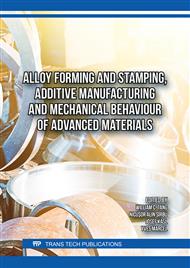p.3
p.15
p.29
p.37
p.47
p.55
p.71
p.85
Exploring the Potential of Superplastic Forming of Ti-6Al-4V Tailored Machined Blanks for Lightweight Design
Abstract:
Tailored machined blanks are sheets that feature heterogeneous thicknesses, allowing different areas of the final part to withstand distinct structural loads effectively. Conventional methods of tailoring the thickness of the final part, like chemical machining, are labour intensive processes that requires pre-masking and post cleaning of complex industrial component. The proposed method provides a cost-effective solution to manufacture light-weight components by simplifying the material removal compared to shaping intricate 3D parts. In fact, machining a flat blank is simpler than removing the material from complex 3D geometries. In this study, the feasibility of superplastically formed Ti-6Al-4V tailored machined blanks was analysed. Three industrial relevant design examples were developed for components forming with initial dissimilar thickness distributions. The results were examined through Finite Element (FE) simulation and experimentation. The FE simulations guided the design of these blanks. Two examples aimed to address the excessive thinning issue typically encountered with standard homogeneous thickness approaches, where specific regions in the part undergo maximum deformation. The blank designs were preserved with higher thicknesses in regions where maximum deformation was expected. The third example explored forming a structured pattern thickness distribution, incorporating thicker stiffeners covering the sheet in two perpendicular directions. Although the approaches differed, the goal of all three designs was to reduce the total weight of the part. The tailored blanks were manufactured via CNC machining from a 2.6 mm thick Ti-6Al-4V sheet, introducing variable thickness profiles. Subsequently, the blanks were superplastically formed in an SPF press. The successful forming of the parts demonstrated the feasibility of the tailored thickness blank approach that can enable the reduction in component weight. Also, this approach can help the industry to phase out chemical milling for the purpose of light-weighting and removing of excess material from post formed component. Importantly, the experimental trials showed good correlation with the FE simulations, emphasizing the crucial role of the FE tool in designing such components.
Info:
Periodical:
Pages:
3-13
Citation:
Online since:
November 2025
Authors:
Keywords:
Price:
Сopyright:
© 2025 Trans Tech Publications Ltd. All Rights Reserved
Share:
Citation:


